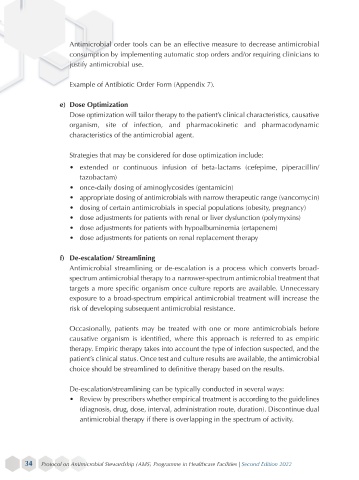Page 36 - C:\Users\ToRiM\Desktop\New folder2\
P. 36
Antimicrobial order tools can be an effective measure to decrease antimicrobial
consumption by implementing automatic stop orders and/or requiring clinicians to
justify antimicrobial use.
Example of Antibiotic Order Form (Appendix 7).
e) Dose Optimization
Dose optimization will tailor therapy to the patient’s clinical characteristics, causative
organism, site of infection, and pharmacokinetic and pharmacodynamic
characteristics of the antimicrobial agent.
Strategies that may be considered for dose optimization include:
• extended or continuous infusion of beta-lactams (cefepime, piperacillin/
tazobactam)
• once-daily dosing of aminoglycosides (gentamicin)
• appropriate dosing of antimicrobials with narrow therapeutic range (vancomycin)
• dosing of certain antimicrobials in special populations (obesity, pregnancy)
• dose adjustments for patients with renal or liver dysfunction (polymyxins)
• dose adjustments for patients with hypoalbuminemia (ertapenem)
• dose adjustments for patients on renal replacement therapy
f) De-escalation/ Streamlining
Antimicrobial streamlining or de-escalation is a process which converts broad-
spectrum antimicrobial therapy to a narrower-spectrum antimicrobial treatment that
targets a more specific organism once culture reports are available. Unnecessary
exposure to a broad-spectrum empirical antimicrobial treatment will increase the
risk of developing subsequent antimicrobial resistance.
Occasionally, patients may be treated with one or more antimicrobials before
causative organism is identified, where this approach is referred to as empiric
therapy. Empiric therapy takes into account the type of infection suspected, and the
patient’s clinical status. Once test and culture results are available, the antimicrobial
choice should be streamlined to definitive therapy based on the results.
De-escalation/streamlining can be typically conducted in several ways:
• Review by prescribers whether empirical treatment is according to the guidelines
(diagnosis, drug, dose, interval, administration route, duration). Discontinue dual
antimicrobial therapy if there is overlapping in the spectrum of activity.
34 Protocol on Antimicrobial Stewardship (AMS) Programme in Healthcare Facilities | Second Edition 2022

